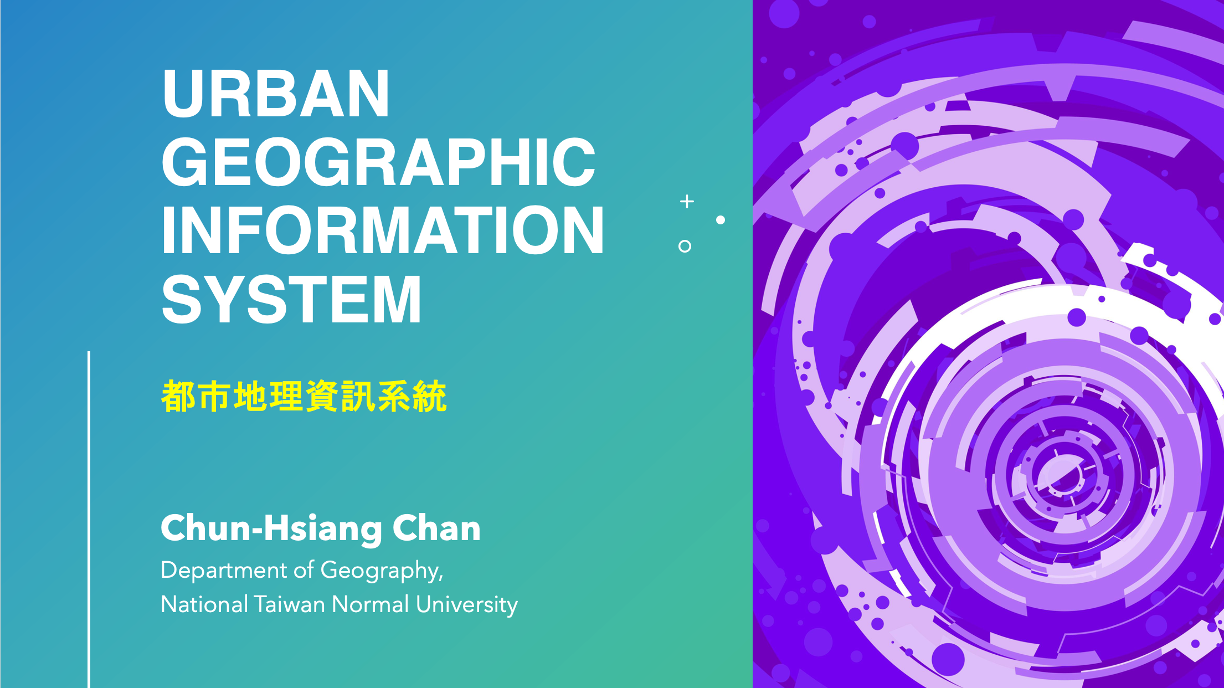Urban Geographic Information System (Python) @ NTNU
Course Content
As the development of air transportation, people are suffered from infectious disease much severe than ever. But how can we help the global public health system from a geographic approach? In the undergraduate courses, you have already understood various spatial analysis methods; however, you seldom apply these methods into your projects or dissertations. Here, we will use three examples to demonstrate the spatiotemporal disease transmission and the applications of spatial analysis in the clinical medicine.
Course Intro.
 01 :: Course Introduction
01 :: Course Introduction
Contents: (1) Course intro (2) Grading policy (3) Why do you need to take this course? (4) What will you learn from this course?
Python Environment Settings
 02 :: Python Environment Settings
02 :: Python Environment Settings
Contents: (1) Anaconda install (2) Hello world (3) Terminal/ Windows powershell (4) Git
Python Basic I
 03 :: Python Basic I – Variables
03 :: Python Basic I – Variables
Content: (1) Variables (2) Data types (3) Numbers (4) Strings (5) Booleans (6) Operators (7) Lists (8) Tuples (9) Sets (10) Dictionaries
Python Basic II
 04 :: Python Basic II – Conditions & Loops & Functions
04 :: Python Basic II – Conditions & Loops & Functions
Content: (1) Conditions (2) For loops (3) While loops (4) Functions (5) Recursive Functions
Python – Statistics I
 06 :: Python – Statistics I
06 :: Python – Statistics I
Content: (1) PCA in Mathematics (2) PCA in Python
Python Visualization
 07 :: Python Visualization
07 :: Python Visualization
Content: (1) Matplotlib (2) Seaborn (3) Plotly (4) Contextily
Python Statistics II & Regression
 08 :: Python Statistics II & Regression
08 :: Python Statistics II & Regression
Content: (1) Statistical analysis (2) Normality test (3) Inferential statistics (4) Correlation analysis (5) Scale problem (6) Regression
Spatial Analysis: OSM
 09 :: Spatial Analysis: OSM
09 :: Spatial Analysis: OSM
Content: (1) Get city list (2) Get map (3) Map view
Spatial Analysis: GeoPandas
 10 :: Spatial Analysis: GeoPandas
10 :: Spatial Analysis: GeoPandas
Content: (1) Read spatial data (2) Visualization with explore (3) Sampling points (4) Spatial Join (5) Clip (6) Dissolve (7) Area calculation (8) Get centroid (9) Distance calculation
Spatial Analysis: Spatial Autocorrelation
 11 :: Spatial Analysis: Spatial Autocorrelation
11 :: Spatial Analysis: Spatial Autocorrelation
Content: (1) Weighting matrix (2) Global Moran's I (3) Local indicators of spatial association – LISA (ESDA & pysal) (4) Weighting matrix (GeoDa) (5) Local indicators of spatial association – LISA (GeoDa) (6) Local Getis-ord statistics (7) Bivariate LISA
Spatial Analysis: GWR
 12 :: Spatial Analysis: GWR
12 :: Spatial Analysis: GWR
Content: (1) Geographically weighted regression (2) Parallel version multi-scale/ normal geographically weighted regression (3) GWR prediction (4) Plot intercept map (5) Plot coefficient map
Spatial Analysis: Spatial Regression
 13 :: Spatial Analysis: Spatial Regression
13 :: Spatial Analysis: Spatial Regression
Content: (1) Spatial generalized linear model (2) Ordinary least squares model (3) Spatial lagged exogenous regression (4) Spatial lagged endogenous regression (5) Spatial error model
Python ML Classification
 14 :: Python ML Classification
14 :: Python ML Classification
Content: (1) Concept of classification (2) Evaluation metrics (3) Model optimization (4) Overfitting vs underfitting (5) Bagging (6) Boosting (7) K-nearest neighbors (8) Decision tree (9) Random forest (10) AdaBoost (11) Gradient Boost (12) XGBoost (13) Naive Bayes (14) Linear SVM (15) Remarks